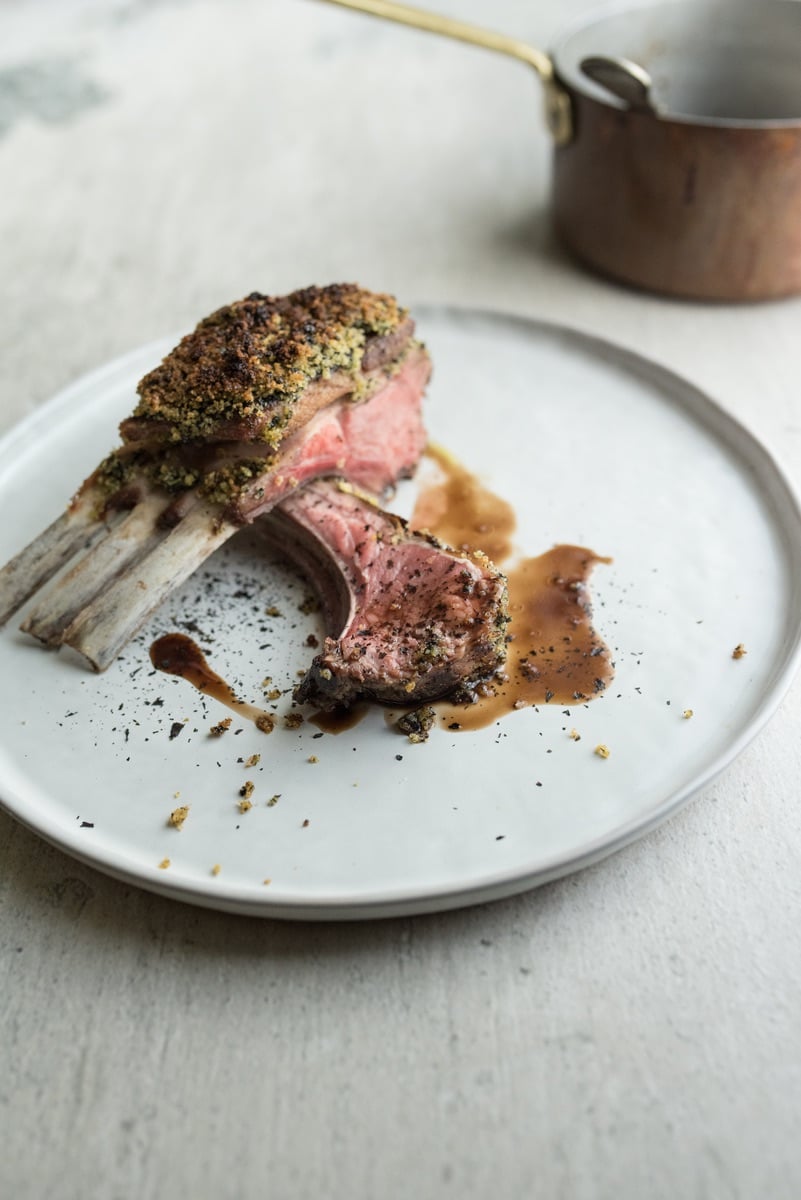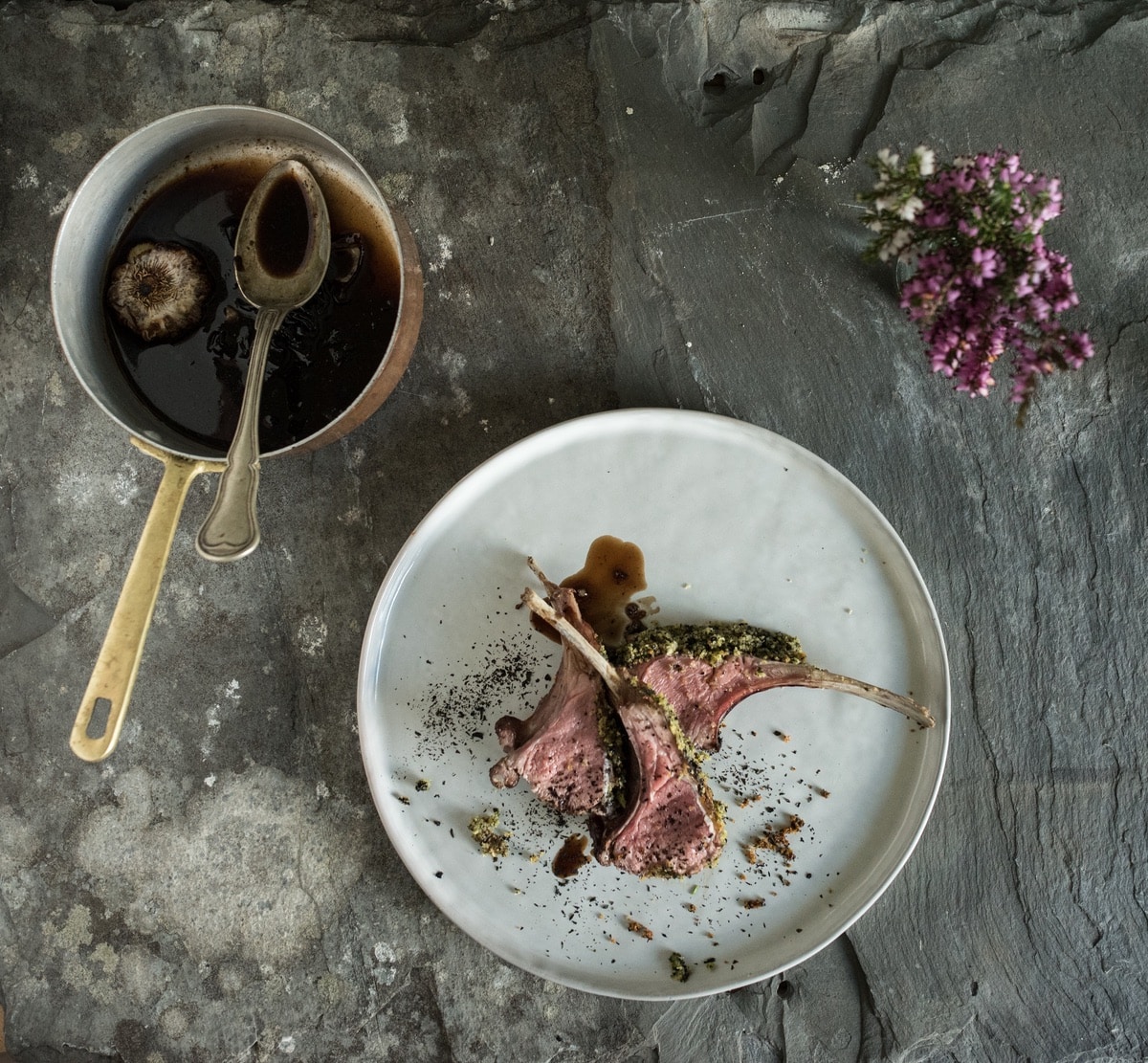
vie-magazine-seaweed-encrusted-lamb-hero-min
From Field to Fork
Story and photography by Cliodhna Prendergast
As you enter the wild countryside of Connemara, you are greeted by the Twelve Bens—the mountain range that reigns majestically over Connemara—the beautiful gleaming rivers, and the still, reflective lakes that define this spectacular landscape. You can sense, beneath the surface of these lakes and rivers, the prized wild salmon and trout that draw fishermen from around the world to this region. Illusive and wily, they do not fall easily to the angler’s fly, which is why a fisherman comes here as much to simply relax in nature as to catch a fish. This is not a numbers game.
As you explore further west, you hit the sea at the end of almost every road and discover the many beautiful white sandy beaches. On days when the light hits the shallow water over white sand, the colour is an incredible turquoise hue, more akin to far-off Caribbean seas, but without the heat.
Visiting the small fishing village of Roundstone you will see the fishing boats coming in from their day at sea with velvet crab, shrimp, and lobster. Cleggan village is another coastal community; here, ferries that cross to the island of Inishbofin sit alongside serious-looking fishing boats. Fishermen in bright yellow overalls rush to unload their catches, which are then taken across the country and exported abroad. Necklaces of ropes for natural mussel farming are strung along the deep Killary fjord where the water is pure and the mussels thrive on the ropes, hanging in the strong tidal currents.
Scenes such as these represent the way of life for the modern hunter-gatherer and are reminders of how important the sea remains in the life and culture of Connemara’s coastal villages.
But the first example a visitor to Connemara will get of the local farming activity and the larder of Connemara comes before the coast. First-time visitors are amazed to discover dayglo-coloured sheep wandering unattended along the roads and on the hillsides. With pinks and blues more reminiscent of punks on the King’s Road in 1970s London, the sheep must look bizarre to the visitor. The colours are, of course, brands to help identify the ownership of the free-roaming sheep that give rise to the most prized of Connemara’s food industry: our lamb.

Grazing on hillsides and bogs that are often commonage land (vast tracts of land owned by a group of farmers who have communal grazing rights), the sheep have a diet that is pure and unique, which gives rise to a unique variety of lamb. So unique, in fact, that it is now recognised and protected within the EU and has been granted status as a product with protected geographical indication or PGI. In the same way as Parma Ham is from Parma and Champagne can only be sold as such if made in the Champagne region, Connemara Hill Lamb is so unique that use of the name is now protected by law.
In this part of the country, we are not blessed with good land, and crops do not grow happily for the most part. Much of the area is either rock or bog land bordering an unbelievable amount of water. Roundstone bog boasts a lake for every day of the year, and when you stand high up on top of one of the Twelve Bens, it is only then you see the vast amounts of water and bog many have built their lives and livelihoods on. Because of this, the sea and the grazing sheep are of the utmost importance.
Here, where the sheep live on the mountains for most of the year, lambing season is more common in late April and May, when the weather is warmer. These lambs are feeding on sorrel, bog myrtle, thyme, heathers, and mountain grasses on the hills right down to the sea in many cases, where I have watched them eat seaweed. They are then brought down to be fattened on sweet summer grasses in the greener fields—or gardens, as they are traditionally called—before killing, which will not happen in most cases until July or August.

True Connemara lamb, due to its hill grazing, will never get as big as those fattened in other parts of the country with more fertile land; however, they will be free from chemicals, fertilisers, and manufactured feed for the most part. They are smaller lambs but much less fatty and have an incredibly sweet flavour, seasoned from the inside out by their wild foraging.
This dish of seaweed-encrusted rack of lamb is a celebration of the sea and the land of Connemara. I collected lots of nori seaweed, also known as laver, on the nearby beach for this. Pepper dillisk works brilliantly with it, as does any other tender seaweed. The seaweed lends an almost mushroom-like flavour to the juices.
Seaweed-Encrusted Lamb
Serves 2
Preheat the oven to 350°F/180°C
Ingredients
1/4 ounce or a large handful dried nori seaweed or other dried tender seaweed
1 cup breadcrumbs
1 tablespoon lovage or parsley, chopped roughly
3 tablespoons salted butter, melted
1 rack of lamb (1 1/4 pound), trimmed
3/4 cup lamb stock
1/2 small head of garlic, cut across the middle, use the bottom half
1/4 cup red wine
Salt and pepper
Method
- In a food processor, chop almost all of the seaweed until it is a coarse powder. Remove a teaspoon of the powder and reserve for the lamb juices. Then add the breadcrumbs and the lovage or parsley and pulse for a moment until everything is mixed thoroughly. Next add the melted butter, pouring it in as the food processor is running. This will form the crust for the lamb.
- Place a pan on a medium to high heat. Season the lamb with salt and pepper and when the pan is hot, sear the lamb all over, which will take about 8 minutes. Remove the lamb from the pan and allow to cool slightly. Remove most of the fat from the pan with a spoon by tilting the pan to the side to keep the juices in while the fat gathers on top.
- Return the pan to medium heat and add the half head of garlic; allow it to brown slightly and remove to a roasting tray. Add the red wine, reduce by half, and then add the lamb stock followed by the teaspoon of seaweed powder. Allow the stock to simmer gently and reduce by half.
- Meanwhile, cover the fatty side of the lamb with the breadcrumb mix, packing it on firmly. Place the lamb alongside the garlic on the roasting tray.
- Place in the preheated oven for about 15 minutes until quite firm to the touch for medium rare, or 20 minutes if you prefer it more well done. Remove the lamb from the oven and allow to rest for 10 minutes. Return the garlic to the pan with the lamb stock and simmer very gently for about 5 minutes. When the lamb is well rested, pour any juices into the stock, slice the rack, and serve with the seaweed lamb juices.
— V —
Share This Story!
KEEP UP WITH THE LATEST STORIES FROM VIE


















































































































































